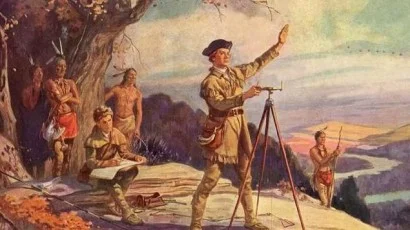George Washington was an avid land surveyor throughout his life, whether in a professional capacity or in taking stock of his own properties. Given his various expeditions to the west, Washington was suited to the challenges presented by laying lines and charting tracts in the Virginia backcountry. Surveying was a respectable profession in eighteenth-century America, holding the promise of social and financial advancement, which attracted Washington to the career. The practical knowledge he acquired surveying, he later used to assist in managing his extensive landholdings.

Over the course of fifty years Washington completed numerous surveys, many documenting the settlement of the territory along Virginia's western frontier. However, others were more local, and laid out the boundaries and agricultural fields of his continually expanding Mount Vernon plantation.
George Washington's experiences as a surveyor began at a young age. As a young man, he was exposed to school exercises that taught the basics of surveying and land measuring. The educational training that Washington received was complemented by practical experience in the field. His first attempts at measuring land occurred in familiar territory at Mount Vernon.
Washington's big break as a surveyor came in 1748 when he was invited to join a survey party organized by his neighbor and friend George William Fairfax of Belvoir. Fairfax assembled an experienced team to layout lots within a large land tract along the western edge of Virginia.1 In addition to closely observing the work over the course of one month, Washington gained important experience living in the West.
Washington's career as a professional surveyor began in 1749. He received a commission from the College of William and Mary to become surveyor for the newly formed Culpeper County.2 Washington immediately traveled to Culpeper, the county seat, to be sworn in. Washington completed his first survey within two days, measuring a tract of 400 acres. At seventeen years of age, he was well on his way to a lucrative career.

In October 1750, Washington left his position as an official surveyor, though he continued to work diligently over the next three years at his new profession. He continued to survey professionally for two more years, mostly in Frederick County before receiving a military appointment as adjutant for southern Virginia. Although Washington did not survey professionally after this date, he continued to utilize his surveying skills. He completed at least fifty more surveys, often for the purpose of acquiring new land for himself, defending his property boundaries, or dividing his holdings into profitable farms.
By 1752, Washington completed nearly 200 surveys totaling more than 60,000 acres. In the field, Washington's basic equipment included a "circumferentor," or plain surveying compass, a brass encased magnetic compass with perpendicular sights attached mounted on a Jacob's staff or tripod, with one or more survey chains. The circumferentor was used by Washington to determine the bearings of boundary lines.
At one time, Washington owned over 60,000 acres between the Potomac and Ohio Rivers.3 Given his extensive landholdings and professional background, he continued to survey his own properties as late as November 5, 1799, a month before his death.
Revised by Zoie Horecny, PhD, 27 March 2025
Notes:
1. “[Diary entry: 14 March 1748],” Founders Online, National Archives.
2. “Memorandum, 1749–1750,” Founders Online, National Archives.
3. “Enclosure: Schedule of Property, 9 July 1799,” Founders Online, National Archives.
Bibliography:
Chernow, Ron. Washington: A Life. Penguin Publishing Group, 2010.
The George Washington Atlas. Washington D.C: United States George Washington Bicentennial Commission, 1932.
“George Washington’s Professional Surveys,” Founders Online, National Archives.
Hughes, Sarah. Surveyors and Statesmen: Land Measuring in Colonial Virginia. Richmond: Virginia Surveyors Foundation and Virginia Association of Surveyors, 1979.

